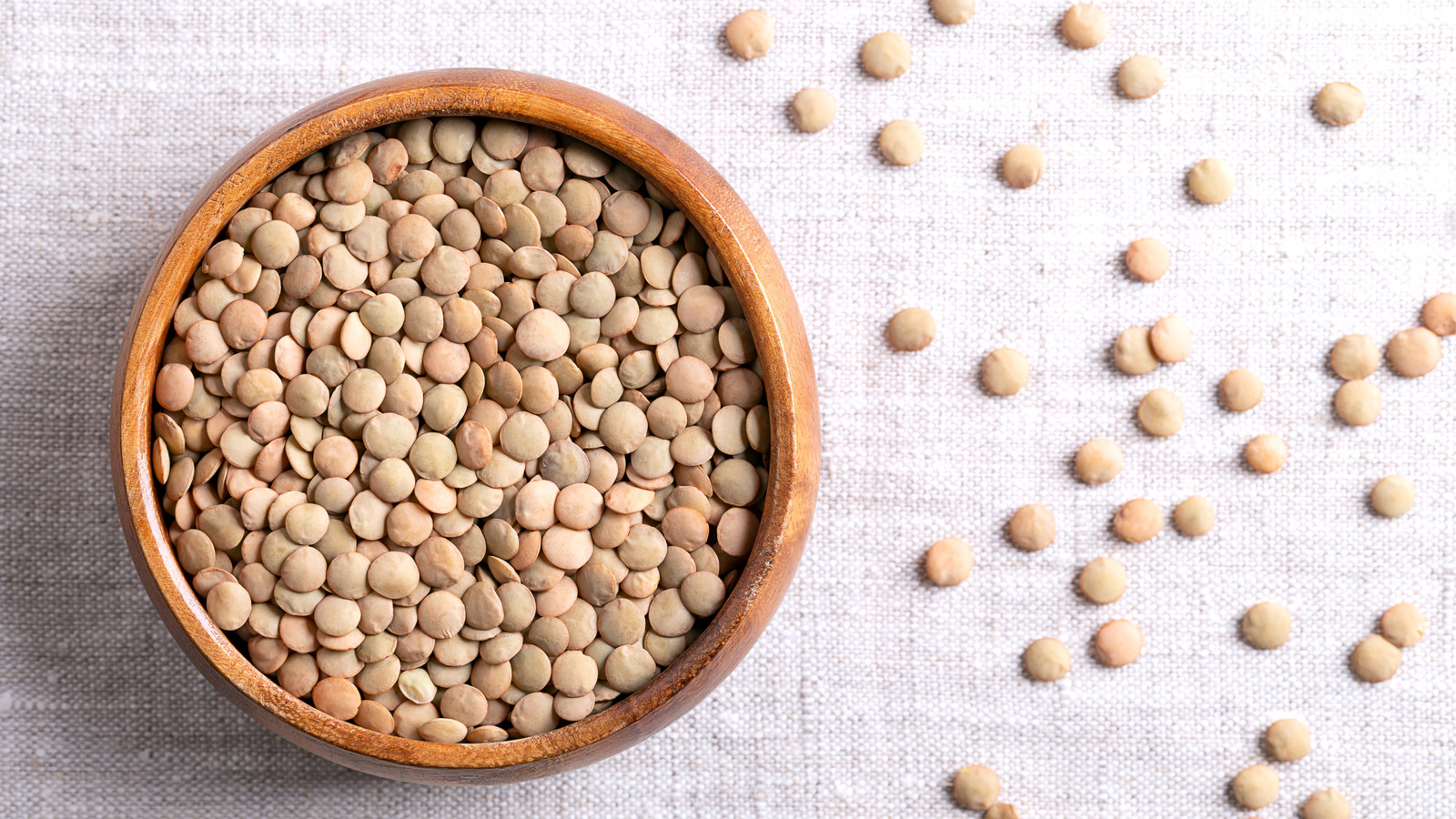We may receive a commission on purchases made from links.
Whether you’re trying to reduce your grocery bill as prices rise, looking for additional sources of iron and fiber in your diet, or generally consuming less meat, lentils are an excellent protein source to turn to. These tiny discs come in a range of textures and colors, and they’re so easy to prepare that they’re one of the best foods to try when you’re first learning how to cook legumes. Lentils are versatile, too; while lentil soup and dal are two of the better-known lentil dishes, you can also use these wonder pulses in many other recipes, including as a substitute for ground beef.
Lentils are inexpensive and available in both canned and dry form. They store well and are among the easier foods to find as so many grocery stores and online businesses carry them. If you’ve never cooked with lentils before and want to know how to get started, here’s some more information about this budget-friendly protein that you should keep stocked in your pantry.
What are lentils?
Lentils are members of the legume family, and many people think of lentils as a type of bean. Lentils and beans are related (they’re both legumes and both considered pulses, which are the seeds of legumes), but they’re not exactly the same and are cooked and prepared in different ways. Lentils come in brown, green, red, and black. You’ll also find yellow lentils that some people lump in with red lentils, even though the red and yellow varieties have slightly different nutritional and flavor profiles.
Yellow and red lentils break down easily during cooking and are terrific for purees and dishes like Indian dal, while brown, green, and black lentils remain intact and work well as a way to add texture to soups, salads, and other dishes. (Fun fact: Legumes are vegetables even though they can serve as the main protein in a meal.)
In general, lentils tend to look like round discs or lenses that bulge slightly on each side. A type of black lentil called the beluga lentil is much rounder; in fact, it got the name “beluga” because it resembles caviar. French green lentils (lentilles du Puy) are also slightly rounder than the brown or red varieties.
Lentils may be sold whole or split in half. Red lentils are much smaller than brown and green lentils, and they cook faster, too. The global supply chain for lentils has been under strain since the pandemic, but conditions are improving as shipping bottlenecks ease.
How are lentils grown and processed?
Lentil plants look like small bushes with thin, almost vinelike stems growing about 1-2 feet in height, with the pods that carry the lentil seeds growing at the ends of the stems. You’ll get up to three lentils per pod. Lentils are grown commercially in the United States (especially in states like Montana, North Dakota, and Washington). Canada, India, and countries in Europe and northern Africa also have substantial commercial lentil agriculture. Like other legumes, lentil plants fix nitrogen in the soil and are a good crop to include in a crop rotation plan. The growing season tends to be from early spring to late summer.
One of the great things about lentils is that the plants are self-pollinating, meaning they don’t need bees or butterflies to come along to spread pollen and jumpstart growth. Growers wait until a certain percentage of pods change color and dry out before harvesting. Then the lentils are hulled, and the chaff is removed. You can grow lentils in your home garden, too, if you can provide a spot with full sun, well-draining soil, and a trellis to help support the thin stems.
Comparing canned and dried lentils
Because lentils are harvested when they’re already dried, you won’t find fresh lentils for sale. But you will find canned lentils and bags of dried lentils just about everywhere (though, according to commenters on Reddit, dried lentils are easier to find at many stores). You’ll also find lentils in bulk-bin dispensers at organic and health-food stores and co-ops.
Canned lentils are usually brown, green, or black, while red and yellow lentils are more commonly sold dry because these types disintegrate into mush when canned in liquid. Lentils are also sometimes ground into flour, and you can find gluten-free, high-protein pasta made with red lentil flour. You may also see sprouted lentils at grocery stores. Sprouting changes the flavor, texture, and nutrition of lentils, and these work well in cold salads.
Dried lentils need to be rinsed off and sorted because tiny pebbles and dirt can end up in the bags along with the legumes. Canned lentils do not need to be sorted, of course, but draining and rinsing them is a good idea. Draining the liquid from canned lentils removes some of the extra sodium content. The liquid from canned lentils can also look unappetizing, and rinsing can remove any that might have stuck to the lentils themselves. Because canned lentils are already effectively cooked, they’re suitable for use in salads or in dishes where you don’t want to wait for them to soften while cooking.
What do lentils taste like?
The only way to really describe the flavor of lentils as a whole is to say that they taste lightly earthy. Some varieties, like green lentils, have a more prominent flavor that many describe as a bit peppery, and some think green lentils have a peppery fragrance, too. Overall, however, lentils soak up whatever flavor you give them. Lentil tacos will not taste like peppered beans, they’ll taste like whatever taco spices you use. Meanwhile, red lentils used in soup or dal will easily take on salty or herby flavors depending on how you season them.
Red lentils are particularly mild. If you want to add protein to a dish without changing the taste much, cooking split red lentils to the point where they’re very soft allows you to mix them into chilis or even hand pies. For all types of lentils, you should add your seasonings and herbs at the beginning of cooking to maximize flavor.
How do you cook lentils?
For canned lentils, most of the cooking is already done. Dump the lentils into a strainer, and rinse them in clean water. Then add them to whatever you want. They can go into salads cold or can make a delicious baked potato topping. If you’re adding them to soup or another hot dish, let them cook for a few minutes to warm up.
Dry lentils need a little more preparation. Pour the amount of lentils you need onto a baking sheet or large plate and start sorting through them. Move them around one by one, removing rocks, lentils that look rotten or discolored, and any other debris. (You may want to sort through them twice if you’re cooking a lot of lentils.) Place the sorted lentils in a strainer and rinse them well under running clean water. Put the rinsed lentils in a saucepan, cover with cold water, bring them to a boil, and reduce to a simmer. Split red lentils can be ready in as little as five to 10 minutes, while thicker brown, yellow, or green lentils can take closer to 30 to 45 minutes.
One thing you need to be aware of is that red lentils can boil over quickly, and usually right at the moment you’ve decided to look away. Don’t walk away from the stove when you’re waiting for the water to boil, and keep a close eye on them during cooking.
Do you need to soak dried lentils or not?
Part of the appeal of lentils is that they don’t need to be soaked before cooking. However, some people claim that soaking lentils is beneficial. Most dried beans need to be soaked because they contain proteins called lectins. These proteins can cause some nasty intestinal problems. Soaking and then cooking the beans reduces lectins to the point where the beans are edible. Lentils don’t have high levels of lectins that could create the same problems as other beans, so soaking isn’t required.
However, there are some arguments in favor of soaking dry lentils for several hours before cooking them. For one, soaking softens the lentils and helps them cook faster. Beyond this, lentils still do contain a small amount of lectins and, because some health conditions may benefit from reducing lectins in food, soaking the lentils before cooking can be a good idea. Many people also like soaking lentils for a very long time to get them to sprout. But, overall, you do not have to soak lentils before cooking them, if you don’t want to.
Lentils as a meat substitute
Lentils, mainly brown and flat green lentils, are a terrific substitute for ground beef. They won’t have the exact taste and texture of meat, but they soak up flavor and are “meaty” enough to be the main ingredient in dishes like vegan meatloaf, vegan burgers, and tacos. You can also use lentils as a filler when you need to stretch the amount of meat you have for a meal. Even red lentils, in all their cooked mushiness, can go into dishes like hand pies.
In general, 1 cup of dried lentils is about the same volume as 1 pound of ground beef, but that’s without any additional ingredients. If you have a recipe that calls for added nuts or brown rice, for example, you may need fewer lentils to reach that same volume. The cooking time will also change; for example, chili with beef needs to simmer for a long time if you want the meat to be very tender. But, if you use lentils in place of the beef you don’t need that same long cooking time. Instead, you may only need to cook the chili for as long as it takes to cook the lentils. You can also combine lentils with hearty grains, like barley, for some extra chewiness, as grains are very good at absorbing more flavor. Use lentils in just about any recipe calling for ground meat, including Sloppy Joes, vegetarian bolognese, and shepherd’s pie.
Nutrition information for lentils
Where to even start when talking about the nutritional benefits of lentils? They’re an absolutely marvelous source of protein, fiber, and iron. Lentils also have decent amounts of manganese (not to be confused with magnesium, although lentils contain some of that, too), potassium, and folate. Exact numbers vary depending on the type of lentils you’re evaluating. However, cooked lentils contain around 18 grams of protein per 1 cup and around 16 grams of fiber.
Lentils themselves are low in sodium, although adding salt during the cooking process will raise the amount. As for iron, you can find roughly 30% of your daily recommended intake in that 1 cup. Each type of lentil has differing amounts of potassium, too, with red lentils containing 273 milligrams per 100 grams, and yellow lentils containing 369 milligrams per 100 grams.
Lentils, like other legumes, are not a complete protein. You need to combine them with other foods to get all the amino acids that your body needs and that it doesn’t make by itself. Animal products are complete proteins, containing all nine essential amino acids. Incomplete proteins contain some, but not all, of these. Lentils are incomplete protein, but ensuring that your diet also includes foods like whole grains, nuts, and vegetables means you’ll get all nine overall.
What are the health benefits of eating lentils beyond simple nutrition?
When you eat lentils, you obviously get some benefits from the basic nutrients you’re ingesting. But the health benefits of eating lentils go beyond just getting more fiber and iron. Eating lentil sprouts is associated with improvements in cholesterol. For example, a 2015 study found that eating lentil sprouts is possibly associated with an increase in HDL (“good cholesterol”) and a decrease in LDL (“bad cholesterol”). The polyphenols in lentils may protect your heart health, too.
Eating lentils may be beneficial for nerve health and promote the formation of healthy red blood cells, too, due to the folate content. The fiber and protein in lentils help increase feelings of satiety after eating, which can reduce the amount of additional food you eat later on, thus contributing to weight control. That fiber can also help promote beneficial bacteria in your gut, which helps your digestive system work a lot better.
Are there any downsides to eating lentils?
Lentils do have some downsides, but they’re very specific. The first is rather obvious: You can be allergic to legumes and be unable to eat lentils. Symptoms of a legume allergy can range from mild discomfort and itching to anaphylactic shock. What’s frustrating about food allergies is that you can become allergic without warning to something you’ve eaten before, and unfortunately, there’s no way to predict if this will happen to you. The good news, though, is that the vast majority of people can eat lentils safely throughout their lives.
The second has to do with something called anti-nutrients. The name comes from the fact that they can bind with carbohydrates in the lentils and prevent absorption. Those lectins mentioned earlier are anti-nutrients and they can give you those bad intestinal side effects if you don’t cook them properly. Lentils also contain tannins and trypsin inhibitors, which interfere with how your body processes protein. And then there’s the phytic acid content, which can prevent the absorption of iron and other minerals. Note that issues with anti-nutrients are more of a problem if you are malnourished or can’t get other nutrients from varied sources. Soaking the lentils before cooking will reduce the amount of phytic acid, lectins, tannins, and trypsin inhibitors.
Where to buy lentils
Lentils are available just about everywhere, from most supermarkets to online sellers. As mentioned, dried lentils are often easier to find than canned in most grocery stores, although canned lentils aren’t exactly scarce and many markets do sell them. Split red and green lentils are among the most common types sold in the U.S. You can also order canned lentils online if you can’t find them on shelves.
Dried lentils are also available online if you don’t want to trek over to your local grocery store. Online ordering allows you to find brands that might not be available in your area, or to find combination packages with different types of lentils, such as this two-pack of Iberia lentils that comes with one bag of green and one bag of red lentils. Online ordering is also a good source for specialty lentils, such as this bulk bag of Yupik Organic Black Beluga Lentils.
How to store lentils
Both canned and dried lentils last a long time when stored properly. Canned lentils, assuming the can is in good shape, should last at least to the best-by date but may still be usable for a few years after that (three to five years after production). However, the longer you wait to eat the lentils, the greater the chance that they could have quality issues like changes in flavor or texture. You should store opened canned lentils in an airtight container in the refrigerator for three to four days. If you need to store them for longer, freeze them. Try to use frozen canned lentils within a couple of months for best quality.
Dried lentils can also last a long time if they’re stored away from light and in an airtight container. They should retain their best level of quality through the best-by date (at least a year). However, they may last for up to three years. Always check dried lentils for signs of rot or mold before using them. And, if you want to store dried lentils for a really long time, vacuum-sealing is the way to go. Store vacuum-sealed packs in a tote or bin with a lid in a cool, dark pantry.





